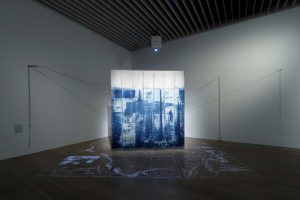Roppongi Crossing 2022 Coming & Going: Mori Art Museum, Tokyo

Seabird Habitats, 2022 (installation view, Roppongi Crossing 2022: Coming & Going, Mori Art Museum, Tokyo, 2022-2023)
Cyanotype, warp-faced pick-up patterns, four-selvaged cloth on Linen
Dimensions variable
Photo: Keizo Kioku, Courtesy Mori Art Museum, Tokyo

Seabird Habitats, 2022 (installation view, Roppongi Crossing 2022: Coming & Going, Mori Art Museum, Tokyo, 2022-2023)
Cyanotype, warp-faced pick-up patterns, four-selvaged cloth on Linen
Dimensions variable
Photo: Keizo Kioku, Courtesy Mori Art Museum, Tokyo

Seabird Habitats, 2022 (installation view, Roppongi Crossing 2022: Coming & Going, Mori Art Museum, Tokyo, 2022-2023)
Cyanotype, warp-faced pick-up patterns, four-selvaged cloth on Linen
Dimensions variable
Photo: Keizo Kioku, Courtesy Mori Art Museum, Tokyo

Seabird Habitats, 2022 (installation view, Roppongi Crossing 2022: Coming & Going, Mori Art Museum, Tokyo, 2022-2023)
Cyanotype, warp-faced pick-up patterns, four-selvaged cloth on Linen
Dimensions variable
Photo: Keizo Kioku, Courtesy Mori Art Museum, Tokyo

Seabird Habitats, 2022 (installation view, Roppongi Crossing 2022: Coming & Going, Mori Art Museum, Tokyo, 2022-2023)
Cyanotype, warp-faced pick-up patterns, four-selvaged cloth on Linen
Dimensions variable
Photo: Keizo Kioku, Courtesy Mori Art Museum, Tokyo

Seabird Habitats, 2022 (installation view, Roppongi Crossing 2022: Coming & Going, Mori Art Museum, Tokyo, 2022-2023)
Cyanotype, warp-faced pick-up patterns, four-selvaged cloth on Linen
Dimensions variable
Photo: Keizo Kioku, Courtesy Mori Art Museum, Tokyo

Seabird Habitats, 2022 (installation view, Roppongi Crossing 2022: Coming & Going, Mori Art Museum, Tokyo, 2022-2023)
Cyanotype, warp-faced pick-up patterns, four-selvaged cloth on Linen
Dimensions variable
Photo: Keizo Kioku, Courtesy Mori Art Museum, Tokyo

Seabird Habitats, 2022 (installation view, Roppongi Crossing 2022: Coming & Going, Mori Art Museum, Tokyo, 2022-2023)
Cyanotype, warp-faced pick-up patterns, four-selvaged cloth on Linen
Dimensions variable
Photo: Keizo Kioku, Courtesy Mori Art Museum, Tokyo

Seabird Habitats, 2022 (installation view, Roppongi Crossing 2022: Coming & Going, Mori Art Museum, Tokyo, 2022-2023)
Cyanotype, warp-faced pick-up patterns, four-selvaged cloth on Linen
Dimensions variable
Photo: Keizo Kioku, Courtesy Mori Art Museum, Tokyo
Haji Oh
1 Dec 2022 - 26 Mar 2023
Roppongi Crossing 2022: Coming & Going
Mori Art Museum, Roppongi, Tokyo
Presented in the exhibition is the work Seabird Habitats (2022), the fourth chapter of Haji Oh’s ‘Grand-mother island project’ which she has been working on since 2017. According to the artist, this project is a large-scale series of works about “the imaginary and multi-sensory space that reveals the interconnectedness between untold stories.”
Having lived in Australia since 2014, Oh highlights the transnational experiences of people (especially women) in the Asia-Pacific region. Among the people who arrived in Australia during the wave of imperialism and modernization were Korean Taiwanese who had immigrated to Australia due to their nation being under Japanese colonial rule at the time. The lives of people who crossed the sea as refugees, prisoners of war, war brides, and pearl divers encounter the lives of viewers through Oh’s works. The seabirds that appear in the work are metaphors for things that traverse borders and symbolize the fate of smaller nations and their people, such as the Republic of Nauru and the rise and fall of its mining industry over the issue of guano resources – the accumulated fecal excrement of seabirds whose uses include the manufacturing of synthetic nitrogen and phosphorus.
Haji Oh, who majored in Dyeing and Weaving at Kyoto City University of the Arts and received her doctorate in 2012, produces works that interweave memories and narratives in a way that is at once personal yet partially shared. She creates a fluid and tender world through engaging in a variety of physical acts that include dyeing threads and weaving cloth, as well as knitting, unraveling, sewing, and embroidering techniques. What served as a major turning point for Oh was her experience of inheriting a chima jeogori outfit that had been left to her by her late grandmother. Oh found herself deeply fascinated by the life, memories, and history of a woman who had immigrated to Japan from Jeju Island in South Korea, as silently reflected through this traditional costume. This inspired her to draw connections between her identity as a third generation zainichi Korean (ethnic Koreans born and raised in Japan)and her artistic practice. Having subsequently lived abroad in Korea for two years to study hanbok making and the Korean language, Oh’s oeuvre not only embodies the time and memories of nameless diasporic women, but also opens up a new future of story sharing through imagination.
Watch Artist Talk:
